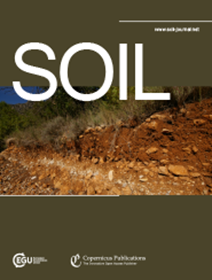环太平洋农业生态系统土壤有机碳预测与气候适应策略
IF 4.3
2区 农林科学
Q1 SOIL SCIENCE
引用次数: 0
摘要
摘要。在气候变率高的环太平洋地区,土壤有机碳(SOC)的准确预测对未来有效的土地管理和气候适应战略至关重要。本研究结合基于cmip6的气候预估,估算了台湾亚热带(卓水河)和热带(老农河)流域土壤有机碳储量的时空分布。本研究收集了1377个土壤样本和18个环境协变量数据,采用立体主义和随机森林算法,并结合回归克里格法,在20 m分辨率下对土壤有机碳储量进行建模。发现基于立体主义的克里格模型在SOC库存预测中具有最高的性能。森林地区被发现含有80%的有机碳储量,热带地区被发现比亚热带地区储存的碳少得多。未来排放情景揭示了碳储量动态的空间异质性。在SSP1-2.6情景下,由于极端降雨事件(R95p和R99p)引起的侵蚀,预测土壤有机碳储量的最大降幅约为20.9%,特别是高地,而在SSP2-4.5和SSP5-8.5情景下,预计土壤有机碳储量将分别增加7.9%至58%;由于TNx和TXx(最低和最高温度极值)的增加导致生产力提高,因此与森林地区特别相关。偏最小二乘路径模型揭示了气候-地形对有机碳储量的相互作用,以地形为主,干旱期延长。研究极端气候、景观类型和有机碳储量之间的相互作用对于增强土壤恢复力和确保未来稳定的有机碳储量至关重要。本文章由计算机程序翻译,如有差异,请以英文原文为准。
Soil Organic Carbon Projections and Climate Adaptation Strategies across Pacific Rim Agro-ecosystems
Abstract. In Pacific Rim regions highly exposed to climate variability, accurate projections of soil organic carbon (SOC) are critical for furture effective land management and climate adaptation strategies. This study integrated digital soil mapping with CMIP6-based climate projections to estimate the spatiotemporal distribution of SOC stocks in subtropical (Zhuoshui River) and tropical (Laonong River) watersheds in Taiwan. We collected 1377 soil samples and data on 18 environmental covariates and modeled SOC stocks at a 20-m resolution through the Cubist and random forest algorithms, which were also combined with regression kriging. The Cubist-based kriging model was discovered to achieve the highest performance in SOC stock prediction. Forested areas were found to contain >80 % of SOC stocks, and tropical zones were discovered to store substantially less carbon than subtropical zones. Future emission scenarios revealed spatial heterogeneity in SOC stock dynamics. In scenario SSP1-2.6, a maximum SOC stock decline of approximately 20.9 % was predicted, particularly for uplands, because of erosion induced by extreme rainfall events (R95p and R99p), whereas in scenarios SSP2-4.5 and SSP5-8.5, increases of 7.9 % to 58 % were predicted, respectively; particularly corresponded to forested areas because of enhanced productivity caused by increased TNx and TXx (extremes of minimum and maximum temperature). Partial least squares path modeling revealed a climate–topography interaction in SOC stocks, dominated by topography and followed by prolonged dry spells. Examining the interactions between climatic extremes, landscape types, and SOC stocks is essential for enhancing soil resilience and ensuring stable SOC stocks in the future.
求助全文
通过发布文献求助,成功后即可免费获取论文全文。
去求助
来源期刊

Soil
Agricultural and Biological Sciences-Soil Science
CiteScore
10.80
自引率
2.90%
发文量
44
审稿时长
30 weeks
期刊介绍:
SOIL is an international scientific journal dedicated to the publication and discussion of high-quality research in the field of soil system sciences.
SOIL is at the interface between the atmosphere, lithosphere, hydrosphere, and biosphere. SOIL publishes scientific research that contributes to understanding the soil system and its interaction with humans and the entire Earth system. The scope of the journal includes all topics that fall within the study of soil science as a discipline, with an emphasis on studies that integrate soil science with other sciences (hydrology, agronomy, socio-economics, health sciences, atmospheric sciences, etc.).
 求助内容:
求助内容: 应助结果提醒方式:
应助结果提醒方式:


